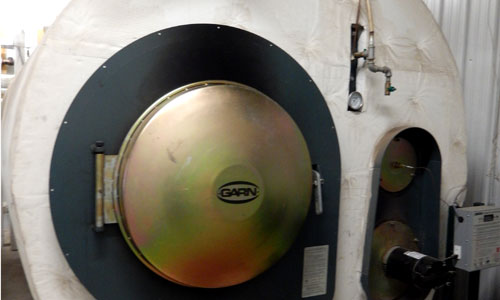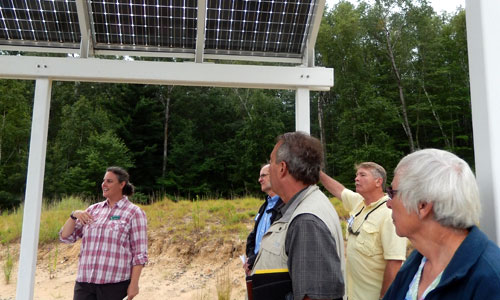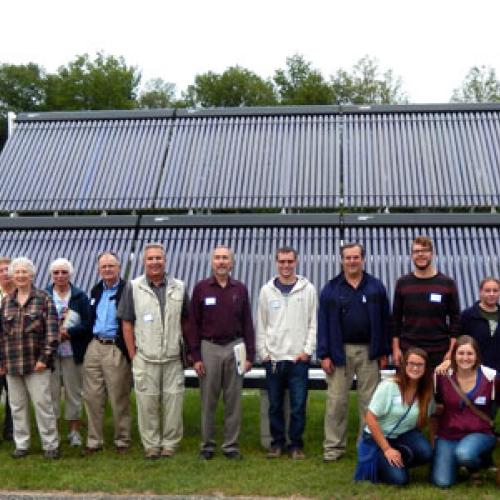Nearly 40 people gathered at Deep Portage Learning Center outside of Hackensack Tuesday, August 6, 2013, for a clean energy tour sponsored by Northwest Clean Energy Resource Team (NW CERT) and Central Clean Energy Resource Team (Central CERT). Deep Portage is a non-profit residential environmental education and outdoor recreation center located in Cass County, Minnesota. The tour highlighted this accredited school’s ten energy efficiency and renewable energy retrofits.
Tour participants started the day by enjoying snacks of homemade zucchini bread (zucchini grown on site), sugar cookies, fresh cantaloupe and coffee, all prepared by Deep Portage’s kitchen staff. The group was then welcomed by Maggie Kozak, CERTs Event Programming Coordinator and Kathy Draeger, Statewide Director of the University of Minnesota Regional Sustainable Development Partnerships. After a round of introductions from attendees, Assistant Director Molly Malecek gave an overview of the Center. Participants divided into two groups for tours led by Molly Malecek and Executive Director Dale Yerger. Molly and Dale provided informative handouts that outlined details of Deep Portage’s renewable energy systems and energy savings (see below).
Starting in 2009, Deep Portage installed ten renewable systems: three wood gasification, one fireplace insert, one wind turbine, three solar photovoltaic electric systems, one solar furnace, and finally, one solar thermal hot water system. Molly Malecek shared that some of the renewable energy installations have fondly been named after board members. There’s “Bud,” the solar panel. “The Norm,” a 6.5 MW photovoltaic solar panel. And “The Betty,” a 130 foot-tall wind turbine named after 92-year-old board member Betty Greene who advocated for wind power when the Center first opened back in the late 1960s.
These energy efficiency and renewable energy systems have resulted in incredible energy, financial, and environmental savings. “When propane hit $2.14/gallon, that’s when we decided to make some changes,” recounted Molly Malecek. In 2007, Deep Portage used 30,778 propane gallons a year. Six years later, they now use only 1,600 propane gallons a year – a dramatic 95% reduction in delivered fuel. “See that propane tank?” Molly asked tour participants. “We used to have six propane tanks on the property. Now we have one. ”
Energy efficiency has played a very important role. Deep Portage’s energy efficiency improvements allowed them to reduce their electric use by 70% in six years, from 225,547 electric kilowatt hours per year in 2007 to 160,000 electric kilowatt hours in 2013.
Fascinating facts:
3 pieces of firewood = 1 gallon of propane, when using a wood gasification system. Now Deep Portage only uses propane for cooking in the kitchen.
Solar power can come from above AND below! In an outdoor solar classroom, sunshine from above produces 6 kW of electricity. From below, the reflection off white painted rocks, a white bench, and snow in the wintertime produces an additional 2 kW of power using bi-facial panels. In addition, these double-sided solar cells provide a roof of shade and rain protection for students and tour participants standing underneath. This unique and innovative structure was designed, provided, and installed by Rural Renewable Energy Alliance (RREAL).
 Wood gasification makes wood burn cleaner. So much cleaner that Molly, who has smoke allergies, is able to heat both her home and workplace with wood gasification. “When I first started this job, it used to be that one camper in the group would have an inhaler. Now it’s common to have 10 kids with inhalers,” Molly shared. In addition to cleaner air, wood gasification also creates jobs in the local economy—both students who chop firewood and add logs to the fire into the wee hours of the night, and local loggers. Even the gasification stove was produced locally, by Garn in St. Anthony, Minnesota. There have been many lessons learned.
Wood gasification makes wood burn cleaner. So much cleaner that Molly, who has smoke allergies, is able to heat both her home and workplace with wood gasification. “When I first started this job, it used to be that one camper in the group would have an inhaler. Now it’s common to have 10 kids with inhalers,” Molly shared. In addition to cleaner air, wood gasification also creates jobs in the local economy—both students who chop firewood and add logs to the fire into the wee hours of the night, and local loggers. Even the gasification stove was produced locally, by Garn in St. Anthony, Minnesota. There have been many lessons learned.
Lessons learned:
“Retrofits are often a little trickier than designing a new system,” explained Molly Malecek. “We’ve had to deal with some odd angles which can make things a little more complicated.”
“Our advice to someone who wants to do wood gasification is to first look at how much room you have for water storage. We didn’t and then we needed to add an additional tank,” said Molly Malecek.
Vertical water tanks allow for better mixing than do horizontal tanks; something that they hadn’t thought about when putting the system in.
As far as predictions of estimated performance in Minnesota winters, “some math was better than expected, some worse”. For example, the Texans who installed the system didn’t know that Deep Portage’s well water is hard and leaves a buildup of minerals. Molly anticipates that at some point, the system may need to be flushed out.
On the up side, “Dale has been vigilant in getting insurance providers to do checkups, and that’s really paid off,” Molly said.
 Know your limitations. Deep Portage only has a half-time maintenance person, so they didn’t want systems that needed a lot of attention. But they do have strong, energetic students who are happy to compete about whose fueling produces more BTUs and keep late-night hours playing ping pong while waiting for the next time to load wood into the gasification system on winter nights of 20 below.
Know your limitations. Deep Portage only has a half-time maintenance person, so they didn’t want systems that needed a lot of attention. But they do have strong, energetic students who are happy to compete about whose fueling produces more BTUs and keep late-night hours playing ping pong while waiting for the next time to load wood into the gasification system on winter nights of 20 below.
Site placement matters. In the summer, solar thermal hot water tubes provide 90% of the hot water needed for kitchen use and showers for students and residential staff. Unfortunately, shade from a neighboring building prevents this system from working during the winter.
Lessons learned and rough patches aside, Deep Portage is very, very happy with the changes it’s made. It cost nearly $875,000 for Deep Portage Learning Center to implement all of these changes and achieve this energy saving, however education and demonstration grants covered $650,000 of the total cost. The Center is grateful for grants from Minnesota Department of Commerce, Division of Energy Resources, Legislative-Citizen Commission on Minnesota Resources (LCCMR), and the U.S. Department of Energy, as well as numerous individual donors. By putting in place energy efficiency and renewable energy retrofits, Deep Portage Learning Center not only reduces its environmental impact, it has also saved thousands of dollars, dramatically reduced its energy use, supports the local economy, and serves as a learning model for Minnesota and beyond.
To see more photos from the event, click play below or click here.
More resources:
- Deep Portage Learning Center’s website
- Details about Deep Portage’s energy systems
- An analysis of Deep Portage’s energy initiatives
- Learn how your public school district, local government, city, or county can fund similar projects
- Learn more about upcoming events in your region


